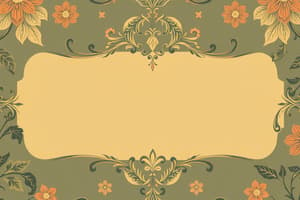Podcast
Questions and Answers
HTML
HTML
- `<fieldset>`
- `<form>` (correct)
- `"Label`
- `<legend>`
<fieldset> HTML
<fieldset> HTML
- .
- .
- . (correct)
- .
<label> HTML
<label> HTML
- . (correct)
- .
- .
- .
<input>
<input>
<br> HTML
<br> HTML
<legend> <fieldset>
<legend> <fieldset>
<thead> <tbody> <tfoot> HTML
<thead> <tbody> <tfoot> HTML
rowspan colspan
rowspan colspan
Flashcards
<Form>
قسم رئيسي في المستند يحتوي على عناصر تفاعلية لإرسال البيانات إلى خادم الويب.
يُستخدم لتجميع عدة عناصر من عناصر <Form> في مستند HTML، مما يسهل استخدام النماذج.
يستخدم لإعطاء كل عنصر من عناصر الإدخال عنوانًا يدل على نوع المعلومات المطلوبة.
<input>
Signup and view all the flashcards
Signup and view all the flashcards
إدخال نموذج
إدخال نموذج
Signup and view all the flashcards
Signup and view all the flashcards
Signup and view all the flashcards
Signup and view all the flashcards
Signup and view all the flashcards
Study Notes
- تطبيقات انترنت
Forms
- Represents a main section in the document that contains elements that the user can interact with to send data to the server.
Fieldset
- Used to group several elements of the form in an HTML document, making the forms easier to use and clearer.
Legend
- Represents a descriptive title or caption for the fieldset element.
Label
- Used to give each element of the input elements a title that indicates what information will be contained in it.
Input
- Used to create interactive forms in web pages that accept data from the user and then send it to the web server.
- The input element exists in several types such as: Text, Password, Button, Checkbox, Radio, Color, Date.
Break
<br> is used to create a new line.
Form Input
- Inputting a form is a group of data.
- The
<form> tag is for inputting data.
<input> contains a document title without table elements, only text (single tag).- Fieldset is a frame for inputting data.
- Legend is to input a title for the document – it has block-level properties.
<br> creates a line break, effectively separating elements.- Checkboxes are used for a selection of appropriate options.
- Label displays an item’s identifying characteristic.
Table
- Creating a table is done via the
<Table> element.
- The
<table></table> is used to express a table.
<tr></tr> (Table Row) is used to express a row.<td></td> (Table Data) is used to express a cell for each row.- Note: The properties
Width (for resizing) and border (for setting the thickness of the boundary) are passed to express the table and its boundaries in pixels.
Table Divisions
- Every HTML table is divided to:
- Table title: Expressed by the
<caption </caption> tag, where the table title is written between this tag pair.
- Table Head: The
<thead></thead> is used to build the table structure and often used to build the title of the table, and should be used before <th> or <td>.
- Table body: The
<tbody> tag contains all the data.
- Table foot: The
<tfoot></tfood> tag is used at the bottom of the table.
Table Example Attributes
- Tables include titles, column headers and data, with options for captions above the table (header).
Table Height for the table height, and Table Width for the table width.- Tables also include cell spacing for padding and cell borders
Elements of a list
- The goal of captions, tfoot, tbady, and theadus. Is designed for organization and distinction.
rowspan is for rows used to merge the cells vertically.colspan is for columns used to merge the cells horizontally.- There are at least 3 items within a code block.
Unordered and Ordered Lists in HTML
- HTML provides two types of list elements: unordered and ordered lists.
- Unordered lists (
<ul>) are used for lists where the order of items does not matter.
- Ordered lists (
<ol>) are used for lists where the order of items is significant.
General HTML Structure
- A HTML page consists of three main parts:
Main area
- This is the main area limited between the
<html></html> tags is the one that determines the beginning and the end of the page, and it contains the head and the body
Head Section
- The part between the tags:
<head></head>, often doesn't appear in web browsers but contains elements and labels . This provides information on content types and hidden information. Search tools use this info for indexing,
Body Section
- The body Section is the area between the tags
<body></body> , which generates the external view of the site
DOCTYPE element
- A declaration element that's used for declaring a page's type.
Meta elements
- Invisible elements added in the head section and area and this is used by search engines to classify and deliver the search results.
- Meta tags consists of these main elements
Charset
- Used to identify the ciphering code.
UTF-8
- The most common ciphering on the internet.
Description
- a quick description of the page's content.
Keywords
- The important words in the page, what users search for.
Heading Tags
- Provides different levels of section headings on a page.
Dir element and values
- Attribute to specify the text direction (right-to-left, or left-to-right).
Elements
- Elements are letters and vocabularies used to label meaning.
- The
Align argument, sets alignment.
Tag Definition
- Tags (e.g.,
<p>) are used to create elements responsible for displaying text passages within HTML.
- Each element in HTML has a beginning tag (Beginning Tag) and an ending tag (End Tag).
Attributes
- Attributes are properties that specify the behavior of an element.
Align
- The
align property specifies the text alignment for the <p> element.
##Center
- Sets the text to the centre.
- Some tags in HTML do not have a closing tag, indicated by a
/ within the element itself (e.g., <img />). This is called self-closing.
Html
- Spacing, white spaces, are not valued on Html, spacing is a way to make the code readable.
Website structure and operation
- Website Design: The process of implementing multiple multimedia content using different description styles.
- This is for easy display on internet surfaces.
- Website parts include Name and topic, files by user, and files used.
HTML and website design
- Important elements are Good Design, user accessibility, and good page connectivity.
- Web design is a collection of web pages placed on multiple servers. HTML is vital in this and other aspects.
Website Design
- Languages used in web design- Jaya Script-XML and HTML
Website Design: Basics
- A web page should have a simple design, easy navigation through elements like Text with a proper structure.
Website structures
- The design should match with the contents.
- The content is well-arranged in the web page.
Website Types
- There are two main types of websites, these are:
- Fixed sites where the customer cannot change anything.
Web Technology
- These types of websites use CSS, HTML( with versions: XHTML) And PHP.
- The customer can change. The main technologies uses are: USP-APP- and Perl and Paython for interactive action. JavaScript and J query is also necessary.
HTML code application
- Hyper Text Markup Language. It is descriptive and the Tags are used for the website structure.
- To write the HTML you can use notepad with an . Html extension, you can use Brackets in Visual studio.
HTML: the versions
- The releases are HTML 2.0, 3, 4, 5
HTML5 Major Changes from HTML
- HTML5 is able to support voice and has a video application.
- Has SVG support, and Canvas. The language of HLL was to use just certain methods with the technology such as Silver-Light.
- HTML5 uses the Structured Way Query code method ( SQL) and data stored in the website
- HTML5 only uses temporary data stored in the website's browser. HTML can be run on background with limited capabilities, the older version runs the process after full web page load.
- The two options have a similar format since they allow structural data, also SAML.
- Supports new models in the management
Code Tags
<html> Indicates the Root Element of Page.<head> indicates the head of the page.<title> Indicates the head title<body> Indicates the main body<p> Indicates the a string of content
Basic HTML requirements
- To learn writing HTML documents:
- You need a notepad as a text editor.
- Google Chrome as a Web browser.
Studying That Suits
You
Use AI to generate personalized quizzes and flashcards to suit your learning preferences.

Related Documents
More Like This
|
Signup and view all the flashcards Signup and view all the flashcards Study Notes
Forms
Fieldset
Legend
Label
Input
Break
Form Input
Table
Table Divisions
Table Example Attributes
Elements of a list
Unordered and Ordered Lists in HTML
General HTML Structure
Main area
Head Section
Body Section
DOCTYPE element
Meta elements
Charset
UTF-8
Description
Keywords
Heading Tags
Dir element and values
Elements
Tag Definition
Attributes
Align
Html
Website structure and operation
HTML and website design
Website Design
Website Design: Basics
Website structures
Website Types
Web Technology
HTML code application
HTML: the versions
HTML5 Major Changes from HTML
Code Tags
Basic HTML requirements
Studying That Suits YouUse AI to generate personalized quizzes and flashcards to suit your learning preferences. Related DocumentsMore Like This |




